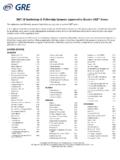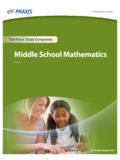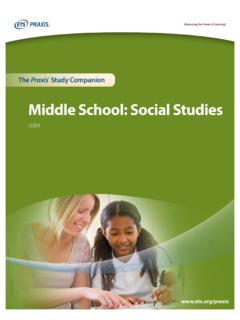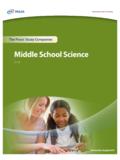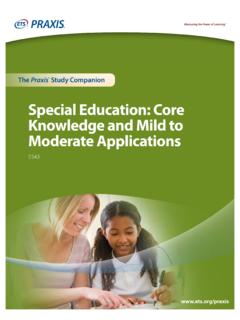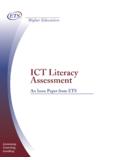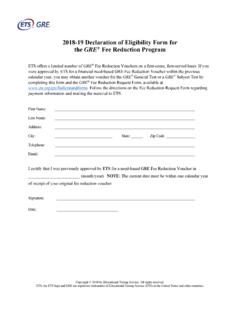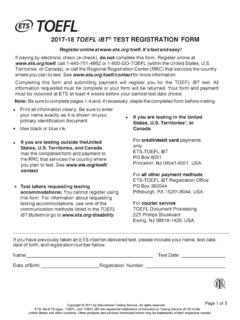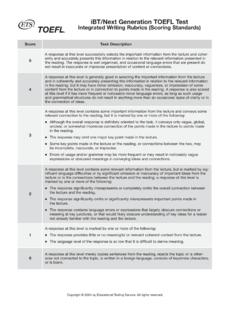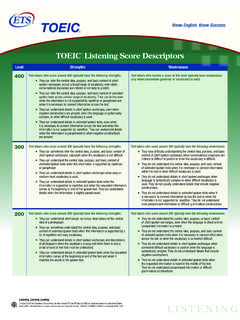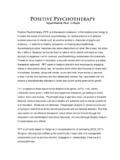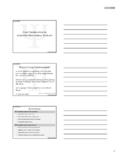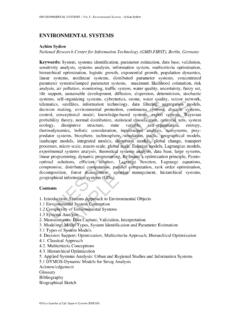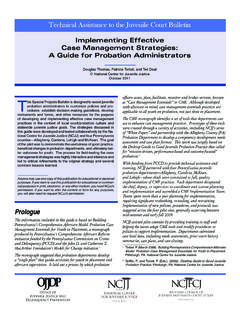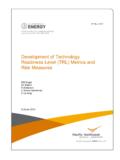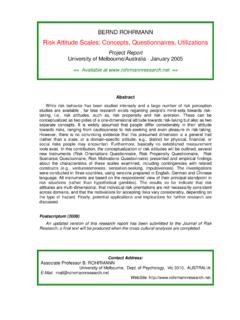Transcription of the and Use TOEFL iBT - Educational Testing Service
1 TOEFL Research Insight Series, Volume 4: validity evidence supporting the interpretation and Use of TOEFL iBT Scores1 validity evidence supporting theInterpretation and Use of TOEFL iBT Scores VOLUME 4 TOEFL Research INSIGHTTOEFL Research Insight Series, Volume 4: validity evidence supporting the interpretation and Use of TOEFL iBT Scores2 TOEFL Research Insight Series, Volume 4: validity evidence supporting the interpretation and Use of TOEFL iBT ScoresPrefaceThe TOEFL iBT test is the world s most widely respected English language assessment and is used for admissions purposes in more than 130 countries, including Australia, Canada, New Zealand, the United Kingdom, and the United States. Since its initial launch in 1964, the TOEFL test has undergone several major revisions motivated by advances in theories of language ability and changes in English teaching practices.
2 The most recent revision, the TOEFL iBT test, was launched in 2005. It contains a number of innovative design features, including integrated tasks that engage multiple skills to simulate language use in academic settings, and test materials that reflect the reading, listening, speaking, and writing demands of real-world academic addition to the TOEFL iBT test, the TOEFL Family of Assessments has been expanded to provide high-quality English proficiency assessments for a variety of academic uses and contexts. The TOEFL Young Students Series (YSS) features the TOEFL Primary and TOEFL Junior tests, which are designed to help teachers and learners of English in school settings. The TOEFL ITP Assessment Series program offers colleges, universities, and others affordable tests for placement and progress monitoring within English ETS, we understand that scores from the TOEFL Family of Assessments are used to help make important decisions about students, and we would like to keep score users and test takers up-to-date about the research results that assure the quality of these scores.
3 Through the publication of the TOEFL Research Insight Series, we wish to communicate to the institutions and English teachers who use any/all of the TOEFL tests about the strong research and development base that underlies the TOEFL Family of Assessments and to demonstrate our continued commitment to the 1970 s, the TOEFL test has had a rigorous, productive, and far-ranging research program. But why should test score users care about the research base for a test? In short, it is only through a rigorous program of research that a Testing company can substantiate claims about what test takers know or can do based on their test scores, as well as provide support for the intended uses of assessments. Beyond demonstrating this critical evidence of test quality, research is also important for enabling innovations in test design and for ensuring that the needs of test takers and test score users are consistently met.
4 This is why ETS has established a strong research base as a fundamental feature underlying the evolution of the TOEFL Family of TOEFL Family of Assessments is designed, produced, and supported by a world-class team of test developers, Educational measurement specialists, statisticians, and researchers in applied linguistics and language Testing . Our test developers have advanced degrees in fields such as English, language education, and applied linguistics. They also possess extensive international experience, having taught English on TOEFL Research Insight Series, Volume 4: validity evidence supporting the interpretation and Use of TOEFL iBT Scores3continents around the globe. Our research, measurement, and statistics teams include some of the world s most distinguished scientists and internationally recognized leaders in diverse areas such as test validity , language learning and assessment, and Educational date, more than 300 peer-reviewed TOEFL research reports, technical reports, and monographs have been published by ETS, and many more studies on TOEFL tests have appeared in academic journals and book volumes.
5 In addition, over 20 TOEFL related research projects are conducted by ETS s Research & Development staff each year and the TOEFL Committee of Examiners (COE), comprised of language learning and Testing experts from the global academic community, funds an annual program of TOEFL research by independent external researchers from all over the world. The purpose of the TOEFL Research Insight Series is to provide a comprehensive yet user-friendly account of the essential concepts, procedures, and research results that assure the quality of scores for all members of the TOEFL Family of Assessments. Topics covered in these volumes include issues of core interest to test users, including how tests were designed, evidence for the reliability and validity of test scores, and research-based recommendations for best close collaboration with TOEFL score users, English language learning and teaching experts, and university scholars in the design of all TOEFL tests has been a cornerstone to their success.
6 Therefore, through this publication, we hope to foster an ever-stronger connection with our test users by sharing the rigorous measurement and research base and solid test development that continues to ensure the quality of the TOEFL Family of John Norris Senior Research Director English Language Learning and Assessment Research & Development Division Educational Testing Service (ETS)The following individuals contributed to the second edition (2018) and the third edition (2020) by providing careful reviews and revisions as well as editorial suggestions (in alphabetical order): Terry Axe, Ikkyu Choi, Michelle Hampton, John Norris, Spiros Papageorgiou, Eileen Tyson, and Yuan Wang. The primary authors of the first edition were Mary K. Enright and Eileen Tyson. Cristiane Breining, Rosalie Szabo, Xiaofei Tang, Mikyung Kim Wolf, and Xiaoming Xi also contributed to the first Research Insight Series, Volume 4: validity evidence supporting the interpretation and Use of TOEFL iBT Scores4 validity evidence supporting the interpretation and Use of TOEFL iBT ScoresValidity is the degree to which evidence and theory support the interpretations of test scores for proposed uses of tests (American Educational Research Association, American Psychological Association , & National Council on Measurement in Education [AERA, APA , & NCME], 2014, p.)
7 11).Test validation is the two-part process of first describing the proposed interpretations and uses of test scores and, second, investigating how well the test does what it is intended to do. Test validation thus starts by establishing an initial argument that states a series of propositions supporting the proposed interpretations and uses of test scores. It then involves posing questions for investigation, collecting data, and summarizing the evidence supporting these propositions (Kane, 2006, 2013). Because many types of evidence may be relevant, especially for high-stakes assessments, validation requires an extended research program. For the TOEFL iBT test, the validation process began with the conceptualization and design of the test (Chapelle, Enright, & Jamieson, 2008), and it continues today with an ongoing program of validation research as the test is being used to make decisions about test takers academic English language iBT test scores are interpreted as the ability of the test taker to use and understand English as it is spoken, written, read, and heard in college and university settings.
8 The proposed uses of TOEFL iBT test scores are to aid in admissions and placement decisions at English-medium institutions of higher education and to support English language this document, we lay out the basic validity argument for the TOEFL iBT test, first by stating the propositions that underlie the proposed test score interpretations and uses and then by summarizing some of the evidence that has been found in relation to each proposition (see Table 1). TOEFL Research Insight Series, Volume 4: validity evidence supporting the interpretation and Use of TOEFL iBT Scores5 Table 1. Propositions and Related evidence in the TOEFL validity ArgumentProposition EvidenceThe content of the test is relevant to and representative of the kinds of tasks and written and oral texts that students encounter in college and university of research and empirical studies of language use at English-medium institutions of higher educationTasks and scoring criteria are appropriate for obtaining evidence of test takers academic language and field studies of task and test design.
9 Systematic development of rubrics for scoring written and spoken responsesAcademic language proficiency is revealed by the linguistic knowledge, processes, and strategies test takers use to respond to test of discourse characteristics of written and spoken responses and strategies used in answering reading comprehension questionsThe structure of the test is consistent with theoretical views of the relationships among English language analyses of field-study results for the testPerformance on the test is related to other indicators or criteria of academic language between test scores and self-assessments, academic placements, local assessments of international teaching assistants, performance on simulated academic tasks, grades, and other indicators of academic successThe test results are used appropriately and have positive of materials to help test users prepare for the test and interpret test scores appropriately; long-term empirical study of test impact (washback)Note.
10 Another important proposition in the TOEFL validity argument, that test scores are reliable and comparable across test forms, is the subject of a separate article ( Educational Testing Service [ETS], 2020).In the following sections, we describe some of the main sources of evidence relevant to these propositions. The collection of this evidence for the TOEFL iBT test began with the initial discussions about a new TOEFL test in the early 1990s. These discussions prior to the design of the new TOEFL test led to many TOEFL Research Insight Series, Volume 4: validity evidence supporting the interpretation and Use of TOEFL iBT Scores6empirical investigations and evaluations of the results. Prototyping, usability, and pilot studies were conducted from 1999 to 2001. Two large-scale field studies were carried out in the spring of 2002 and the winter of 2003 2004.
